There’s something irresistible about fried green tomatoes. Crisp on the outside, tangy and tender inside. They’re a Southern classic that’s made its way into kitchens everywhere.
But here’s the truth: sumptuous fried green tomatoes start with the right green tomato. Pick the wrong ones, and you’ll end up with mush or bitterness.
So, how do you know which green tomatoes are the good kind? Whether you grow them in your backyard or shop at the farmers market, this guide will help you pick the perfect tomatoes for frying.
How to Identify the Right Tomatoes for Frying
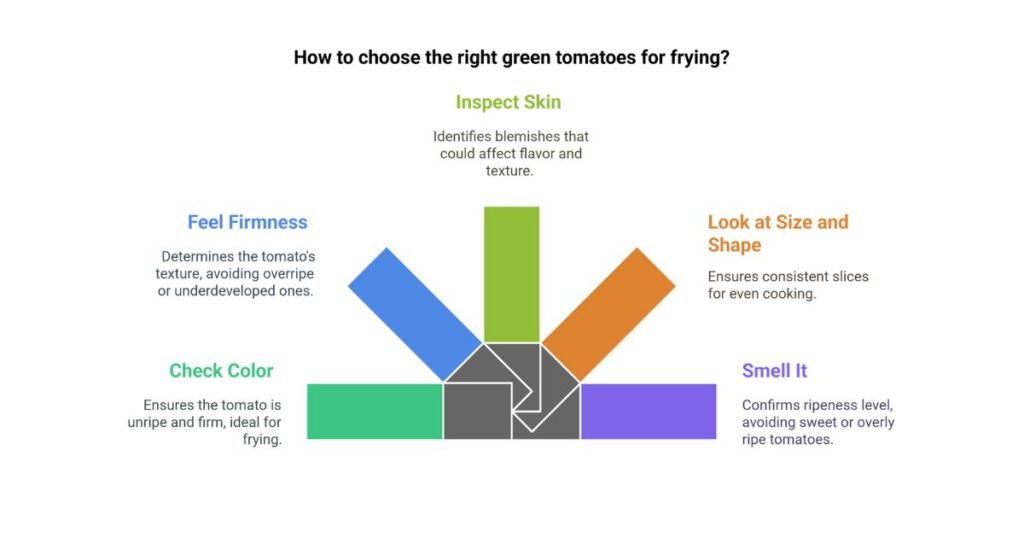
Picking the right green tomato is like choosing the right avocado—not too hard, not too soft, and just the right stage of development.
If you’re aiming for that perfectly crisp, golden-brown bite, you’ve got to start with tomatoes that meet specific criteria. Let’s break it down so you know exactly what to look for.
1. Check the Color Carefully
Color is your first and easiest clue. Green tomatoes used for frying are not a special variety—they’re just unripe tomatoes. But even among unripe tomatoes, there’s a sweet spot in color.
What to look for:
- Bright, even green all over
- A slight pale yellow tint is okay (they’re almost ripe but still firm)
- No signs of red, pink, or orange anywhere
Why this matters:
Still green tomatoes inside and out have a firmer texture and a tangy, almost citrusy flavor. This is precisely what you want for frying. As soon as they start turning color, the inside softens and gets sweet—great for sauces, not for crisp slices.
Pro Tip: A tomato that’s too green may taste overly sour. A tomato that’s too red will be mushy when fried.
2. Feel the Firmness
After color, texture is the next big clue. Please pick up the tomato and give it a gentle squeeze.
You’re aiming for:
- Firm but not rock hard
- Slight give under pressure
- No soft spots or squishiness
Why firmness matters:
Green tomatoes that are too hard might be underdeveloped and chalky inside. Too soft ones have already started ripening and will break down when you fry them.
You want a tomato that feels like a firm peach or an almost-ripe avocado, not like a tennis ball or a water balloon.
Avoid these:
- Soft spots = overripe
- Hard as a rock = underripe and sour
Rule of Thumb: If your thumb leaves a dent, it’s too soft. If it feels like pressing a stone, it’s too hard.
3. Inspect the Skin for Blemishes
Visual inspection can save you time and disappointment. The skin is your tomato’s armor and if it’s damaged, chances are the inside is too.
Look for:
- Smooth, tight skin
- Consistent coloring
- No wrinkles or cracks
Avoid these issues:
- Deep cracks or scarring
- Mold or dark brown spots
- Wrinkled skin (indicates dehydration or over-ripeness)
- Bug holes or bite marks
Why this matters:
Damaged skin can affect the flavor and cause the tomato to fall apart while frying. Plus, blemished tomatoes often have uneven textures, meaning some slices will be firm and others will turn mushy.
Quick Tip: Small surface scratches are okay—just slice them off. But if there’s soft rot, toss it.
4. Look at the Size and Shape
It’s not just what’s inside that counts, shape and size affect your frying game, too. You want wide, round tomatoes that can be sliced into thick, even pieces.
Ideal traits:
- Medium to large size (fits in your palm)
- Round and uniform shape
- No deep ridges or strange bumps
Why size and shape matter:
Big, round tomatoes give you consistent slices that cook evenly. Irregular or heavily lobed tomatoes may fry unevenly or fall apart in the pan.
Best for frying:
- Beefsteak
- Celebrity
- Green Zebra (naturally green, but still incredible)
- Early Girl
Not ideal:
- Cherry or grape tomatoes (too small)
- Tomatoes with deep cracks or bulges (hard to slice evenly)
Bonus Tip: The flatter and rounder the tomato, the easier it is to cut into thick, fryable slices.
5. Smell It (Optional But Helpful)
Most people don’t think to smell their tomatoes, but your nose can offer some great clues about ripeness.
Here’s the breakdown:
- No scent at all? Still unripe—suitable for frying.
- Fresh, earthy smell? Perfect stage.
- Sweet or tomatoey smell? It’s ripening—skip it for frying.
Why smell helps:
A strong tomato aroma means sugar is developing inside—it’s turning red. While that’s delicious for salads and sauces, it’s not what you want in a fried green tomato. The classic fried flavor comes from that slightly tart, green-fresh bite, not sweetness.
Smell test hack: Give the tomato a sniff where the stem was. That’s where the aroma is strongest.
Best Tomato Varieties for Fried Green Tomatoes
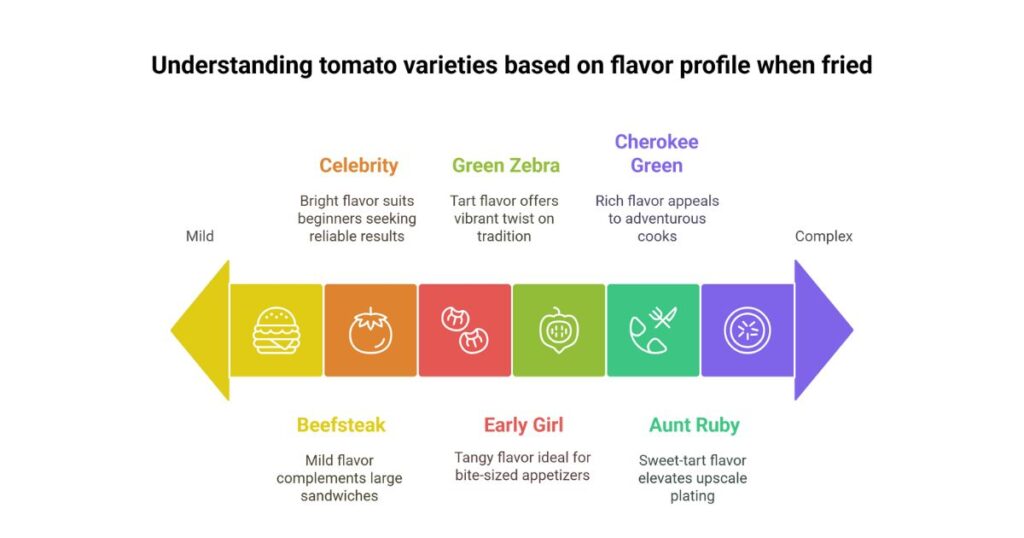
Not all tomatoes are equal when it comes to frying. You want dense flesh, low moisture, and a firm texture that can hold up to slicing, dipping, breading, and frying.
Let’s explore the top picks that work beautifully for this Southern classic.
1. Beefsteak Tomatoes
Beefsteaks are large, meaty, and have fewer seeds and pulp than many other types. When picked green, they offer thick, wide slices that fry evenly and stay intact in hot oil.
Flavor: Mild and slightly tangy when green
Slice size: Big and bold—ideal for layering or stacking
Perfect for: Extra-large fried green tomato sandwiches.
2. Celebrity Tomatoes
Celebrity tomatoes are known for their uniform size and disease resistance, but they also make amazing fried slices. When picked green, they offer that perfect combo of tang and texture.
Flavor: Bright and a bit acidic
Slice size: Medium and easy to handle
Best for: Beginners looking for reliable results every time
3. Early Girl Tomatoes
Early Girls ripen faster, so they’re often picked green early in the season. They’re slightly smaller but dense, which makes them an excellent option for smaller fried slices.
Flavor: Tangy and snappy
Slice size: Smaller, more compact rounds
Great for: Bite-sized fried tomato appetizers or stacking on sliders
4. Green Zebra Tomatoes
Why they’re great:
Green Zebras are a naturally green variety—even when fully ripe, they stay green with light striping. Unlike most green tomatoes, they’re bred to be eaten green.
Flavor: Tart with a fruity finish
Texture: Firm and crisp, even when fully ripe
Ideal for: A vibrant, colorful twist on traditional fried green tomatoes
5. Cherokee Green Tomatoes
Why they’re great:
This heirloom variety stays green when ripe but has a more complex flavor. While it’s softer than a typical unripe red tomato, it’s still firm enough to slice and fry if picked early.
Flavor: Rich and earthy
Best stage to pick: When it’s green with slight yellow undertones
Recommended for: More adventurous cooks looking for flavor depth
6. Aunt Ruby’s German Green
Why they’re great:
This one is a favorite among heirloom growers. It’s large, green, and incredibly flavorful with a slight sweetness. It’s perfect for frying and has a unique flavor when picked early.
Flavor: Sweet-tart, almost tropical
Size: Big and juicy, but firm enough when picked early
Works best for: Fancy fried green tomato dishes or upscale plating
When to Pick Green Tomatoes for Frying
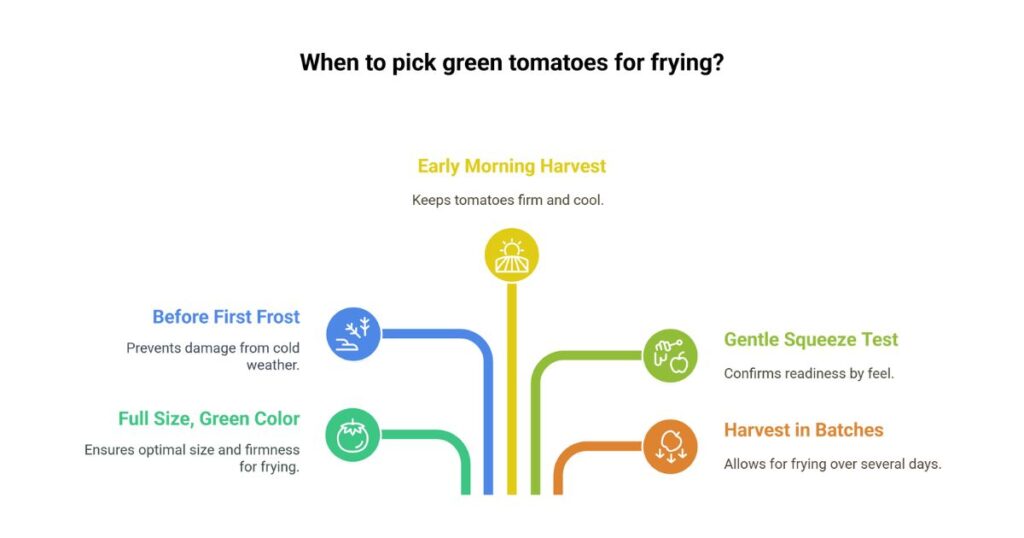
Picking at the right time is just as important as choosing the right variety. A green tomato picked too early can be too sour and complex, while one picked too late might be too soft or sweet.
Here’s how to time your harvest or selection just right:
1. Pick When the Tomato Has Reached Full Size (But Before Color Change)
This is the golden rule:
✅ Full-size tomato
❌ No blush of red, pink, or orange
If the tomato looks fully grown but is still a solid green (or has just a slight pale yellow tint), it’s ready for frying.
🍅 “It should look like a red tomato in size and shape, but still be completely green.”
2. Before the First Frost
If you’re growing your tomatoes, don’t wait too long in the season. A sudden cold snap can damage the plant and the fruit, causing soggy or tasteless tomatoes.
When to pick: A week or two before your area’s average first frost
Why: Cold weather turns green tomatoes mealy and dull in flavor
3. Early in the Morning Is Best
Tomatoes picked in the early morning are firmer and cooler, especially in warmer climates. Sun exposure during the day can soften them slightly, affecting how they fry.
Bonus tip: If the plant is still wet with dew, let it dry off a bit before harvesting to avoid mold in storage.
4. Feel Is Better Than Guesswork
Even if the tomato looks green, test with a gentle squeeze. If it gives slightly and isn’t hard like a rock, it’s likely ready to fry.
Signs it’s ready to pick:
- Uniform green skin
- Slight give when gently squeezed
- Fully formed shape (no shriveled edges)
- No signs of cracking or bruising
5. Harvest in Batches
You don’t need to pick all your green tomatoes at once. If you plan to fry them over several days, harvesting in stages is better.
- Pick firmer ones first (fry them last)
- Pick slightly softer green ones to use immediately
How to Store Green Tomatoes Until You Fry Them
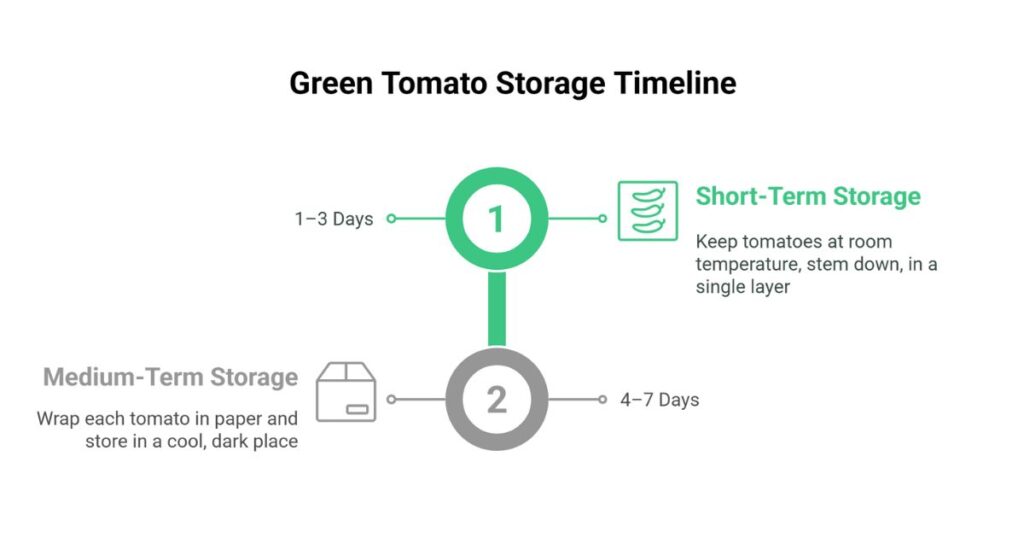
You picked the perfect tomatoes—nice! Now let’s ensure they stay that way until they hit the pan.
1. Short-Term Storage (1–3 Days):
If you’re planning to fry them soon:
- Leave them at room temperature.
- Please place them in a single layer on a tray or plate.
- Keep away from direct sunlight or heat.
- Do not stack them—they bruise easily.
✅ Best storage tip: Store stem side down. It reduces moisture loss and protects the fruit.
2. Medium-Term Storage (4–7 Days):
Need a few more days? Try this method:
- Wrap each tomato in newspaper or a paper towel to prevent ripening and bruising.
- Store in a cool, dark spot like a pantry or cellar (not the fridge).
- Check daily for signs of ripening (yellowing, softening).
📦 Pro tip: Cardboard boxes work great—line them with paper, add a single layer of wrapped tomatoes, and don’t seal the lid completely.
Signs Your Green Tomato Is Ready to Fry
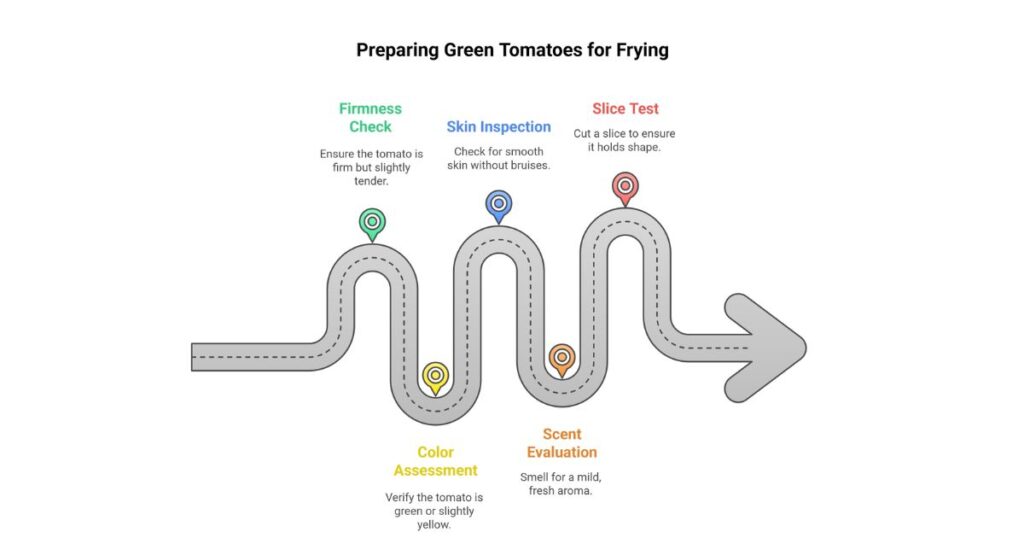
So, how do you know when to slice and sizzle? Look for these clear signs:
✅ Firm but Slightly Tender
The tomato should feel firm but not rigid. Pressing it gently should give just a little, like pushing on a pool toy.
“If it’s soft like a sponge or hard like a rock, it’s not the one.”
✅ Still Green (or Very Slightly Yellow)
It should still look green overall. A pale yellow blush is delicate, but don’t fry it if it’s turning orange or red. Save it for salad or salsa instead.
✅ Smooth Skin, No Bruises
Before slicing, do a quick once-over:
- No soft spots
- No cracks or open blemishes
- Skin is smooth and tight
These signs ensure the tomato won’t fall apart in the pan.
✅ Mild Fresh Scent
Please give it a sniff. A light, earthy aroma is ideal. If it smells sweet or strongly of “tomato,” it’s likely ripening too much.
✅ Slices Hold Shape
Cut a test slice:
- Does it hold together?
- Is the center firm, not mushy?
- Can it handle dipping in flour, egg, and breadcrumbs?
If yes, you’re ready to fry.
Final Thought
Fried green tomatoes might seem simple, but the truth is that it all begins with the right tomato.
If you pick too early, they’re hard and bitter. Too late? They’re mushy and messy. But when you find that just-right green tomato—firm, fresh, and full-sized. It’s like unlocking the perfect ingredient for crispy, golden goodness.
Whether you’re harvesting from your garden or browsing the farmers market, remember these essentials:
- Look for a solid green colour with a slight give.
- Avoid ripening or damaged tomatoes.
- Store them smart to preserve that perfect texture.
With the right variety, timing, and care, your fried green tomatoes will hit that crave-worthy crunch every time.
So slice, coat, fry, and enjoy every tangy, crispy bite.
FAQs
Can I fry green tomatoes, which are still very hard?
You can, but they may be overly sour and not as enjoyable. Letting them soften slightly until they have just a bit of give when pressed is better.
Are green tomatoes safe to eat?
Yes! Green tomatoes (unripe red ones) are safe to eat and delicious when cooked. Don’t eat them raw in large amounts, especially if you have a sensitive stomach.
What’s the best way to store green tomatoes for a few days?
Keep them at room temperature in a single layer, ideally wrapped in paper or stored in a ventilated box. Avoid refrigeration.
Can I use heirloom tomatoes for frying?
Absolutely! Heirlooms like Green Zebra, Cherokee Green, and Aunt Ruby’s German Green are excellent choices, especially if picked slightly underripe.
What oil should I use for frying green tomatoes?
Choose oils with a high smoke point, such as vegetable oil, canola oil, or peanut oil. These oils fry evenly and don’t overpower the tomato’s flavor.










